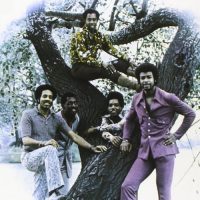Seemingly every musician in the late ’60s was cruising on psychedelic control, or at least tampering with the genre. But not the Motown artists. Berry Gordy, president of the mighty Detroit, Michigan-based imprint, preferred to keep his acts locked in a comfort zone, producing the same classy soul-soaked pop they had been experiencing universal success with for several years.
The Temptations, however, were eager to emerge from the cocoon and finally broke the ice with a pair of great early-1969 singles, “Cloud Nine” and “Runaway Child Running Wild” from Cloud Nine that were just as daring as anything the heavy rock bands of the day were laying down.
Then came Puzzle People. Released on Sept. 23, 1969, this project found the Temptations not only adopting contemporary visions with a natural flair, but enriching such accessories with their own brilliant ideas. A smartly dappled homogenization of styles penetrate the environment, resulting in a superb set of songs promoting a diverse display of moods and feelings.
As noted, Berry Gordy’s fear of commercial loss was all for naught when the Temptations dropped the gloss and polish in favor of a more progressive stance. The applause continued with the anti-materialism missives and the savage funk rock of Puzzle People’s “Don’t Let the Joneses Get You Down” and equally electrifying fury of “I Can’t Get Next To You,” which hit No. 20 and No. 1 on the national charts respectively.
Splattered with wild and wicked jams, engaging sound effects and rounds of reverb, Puzzle People quivers and quakes to a storming collision of hard-edged soul, blistering funk fumes and acid-baked artiness. The harmonies are bold, brash and breathtaking, and the songs are inventively structured and delivered with hearty passion. Stabbing guitar licks, grinding keyboards and punishing rhythms additionally sweep the floor.
Always an ace group, the Temptations are at the peak of their powers here, making it obvious they’re enjoying each moment of the ride.
Lengthy tracks like “Slave” and “Message From a Black Man” roll, wind and ripple on with potency, while a fuzzed-out cover of “It’s Your Thing” by the Isley Brothers, along with interesting renditions of Roger Miller’s “Little Green Apples” and “Hey Jude” from the Beatles further fill the plate.
The result is one of the best albums imaginable – no matter what form of music we’re referring. Brimming with hope and ambition, the Temptations’ Puzzle People is a masterpiece of its era, recorded by a group that knew exactly what they wanted to accomplish and how to go about doing so.
- ‘Magic’ Wasn’t One-Hit Wonder Pilot’s Only Quirky, Radio-Ready Treasure - April 18, 2025
- How ‘Hollies Sing Hollies’ Showed New Promise After Graham Nash’s Exit - November 14, 2024
- Barry Melton on Country Joe and the Fish, Woodstock – and That Chant - August 15, 2024




